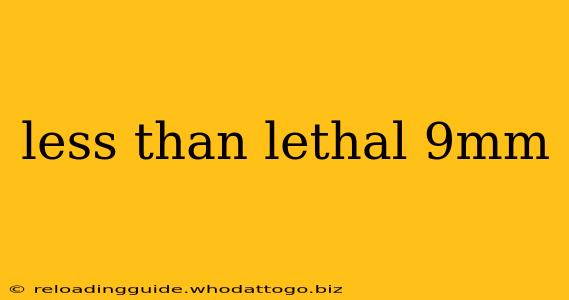The demand for less-lethal options in self-defense and law enforcement is constantly growing. While firearms offer a powerful deterrent, the potential for severe injury or death necessitates exploring alternatives. This guide delves into the world of less-than-lethal 9mm ammunition and devices, examining their effectiveness, limitations, and considerations for responsible use.
Understanding "Less-Than-Lethal"
It's crucial to understand that the term "less-lethal" doesn't guarantee zero risk of injury or death. These options aim to reduce the likelihood of severe harm compared to traditional lethal ammunition. The effectiveness of any less-lethal weapon depends heavily on factors like the distance to the target, the point of impact, and individual physiology.
Types of Less-Than-Lethal 9mm Ammunition and Devices
Several options exist, each with its own advantages and disadvantages:
1. Rubber Bullets/9mm Foam Rounds:
- Mechanism: These rounds utilize rubber or foam projectiles designed to incapacitate through blunt force trauma.
- Effectiveness: Effective at close range for temporary incapacitation, but accuracy and range are limited. Over-penetration is also a potential risk.
- Considerations: Requires careful aiming and appropriate training to minimize the risk of injury.
2. 9mm marking rounds:
- Mechanism: These rounds fire paint or dye markers, primarily for marking suspects or targets.
- Effectiveness: Primarily for marking and identification; not designed for incapacitation.
- Considerations: Primarily for law enforcement purposes. Limited impact on stopping threats.
3. Less-lethal 9mm conversion kits:
- Mechanism: Adapts existing 9mm firearms to fire less-lethal projectiles.
- Effectiveness: Varies depending on the specific kit and projectile used. Some kits provide greater accuracy than direct-fire less-lethal options.
- Considerations: Requires specialized knowledge and training to ensure proper functionality and safety. Conversion kits may have compatibility issues with certain firearm models.
4. Specialized 9mm "kinetic" rounds:
- Mechanism: These rounds utilize specialized projectiles designed to cause a significant impact without the same level of penetration as traditional bullets.
- Effectiveness: Can offer a balance between incapacitation and reduced risk of severe injury compared to traditional rounds.
- Considerations: The effectiveness of these rounds can vary widely based on the design of the projectile.
Limitations of Less-Than-Lethal 9mm Options
It's essential to acknowledge the limitations:
- Distance: Most less-lethal options are significantly less effective at longer ranges.
- Accuracy: Achieving accurate shots can be challenging, especially under stress.
- Penetration: Even less-lethal rounds can penetrate clothing and cause injuries. The risk of over-penetration necessitates careful consideration of the surroundings.
- Effectiveness Variation: Factors like the target's size, build, and clothing can drastically affect the impact of a less-lethal round.
Legal Considerations and Responsible Use
The legal implications of using less-than-lethal weapons vary widely depending on jurisdiction. It's crucial to understand local and state laws before possessing or deploying any less-lethal device. Training is paramount, encompassing proper handling, aiming, and understanding the limitations of these tools. Improper use can lead to severe injury or legal repercussions.
Conclusion
Less-than-lethal 9mm options offer an alternative to traditional firearms, but they are not without limitations and risks. Thorough research, appropriate training, and a clear understanding of legal restrictions are paramount before considering the use of these tools. Always prioritize safety and responsible handling. Consult with law enforcement or a qualified firearms instructor for expert guidance.

